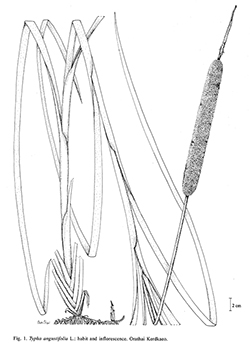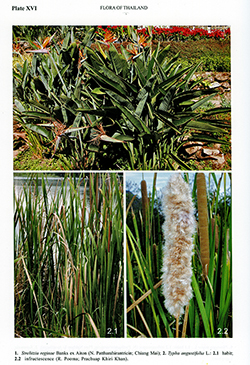e-Flora of Thailand
Volume 9 > Part 2 > Year 2008 > Page 176 > Typhaceae > Typha
Typha angustifolia L.wfo-0000594497
Sp. Pl. 2: 971. 1753; Camus in Lecomte, Fl. Indo-Chine 6: 1070. 1934; Backer in Fl. Males., ser. I, 4: 243. 1951; P.H.Hô, Câyco Viêtnam III. 1: 495. 1993. Fig. 1; Plate XVI: 2.
Accepted Name : This is currently accepted.
Description : Robust perennial. Stems terete, 1.5–3 m by 0.4–0.7 cm. Leaves 52–120 cm by 4–12 mm, convex on abaxial side, transverse section semicircular. Spike: staminate part 8–40 cm by 2–7 mm, with 1–3 deciduous bracts; pistillate part (5–)15–30 by 0.6–2 cm, mid-to dark brown, cushion-like when mature, separated from staminate part by a sterile axis 2.5–7 cm long; stamens 3, rarely 2 or 4; anthers 1.5–2 mm long; female flowers with bracteoles; bracteoles filiform, whitish; ovary fusiform; stalk slender, ca 5 mm long; styles 1–1.5 mm long; stigmas linear to lanceolate, 1.3–1.8 mm long; hairs on stalk shorter than style. Fruit long-elliptic.
Thailand : Common throughout Thailand.
Distribution : Temperate to tropical regions worldwide (Europe – type).
Ecology : On or near the margins of ponds, lakes, ditches, canals, often forming large stands.
Vernacular : Kok chang (กกช้าง)(Central); thup ruesi (ธูปฤาษี)(Bangkok); ya salap luang (หญ้าสลาบหลวง)(Northern).
CommonName : Lesser reedmace.
Uses: Leaves used for thatching, matting and basket-work. The dried inflorescences are used for decoration.
Notes: A variable species. The size of the inflorescence increases with maturity and there is little doubt that all the Thai material falls under the one taxon. Although common the plant is not often collected and its widespread distribution is not well reflected by the material available in herbaria.


